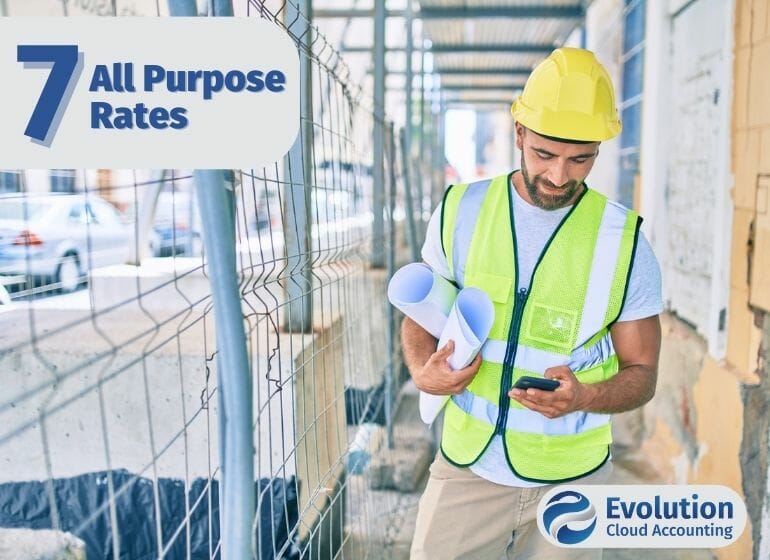7 Accounting Terms for the Construction Industry
By Paolo, 16.07.2023

The Building & Construction Industry has some of the most complex requirements in Australia.
In this blog, we will cover the 7 Key Accounting terms that any Business in the Construction Industry should be familiar with and answer the common questions about them.
1 TPAR – Taxable Payments Annual Report

The Taxable Payments Annual Report is a report that includes all payments a business in the Building & Construction Industry has made to its subcontractors over the Financial Year.
The report must be lodged to the ATO by the 28th of August each year.
Do I have to include both my Sole Trader and Company contractors?
All entity types must be included in the TPAR,the Contractor’s Legal Structure is irrelevant for the purpose of this report.
Do I have to include all Subcontractors in the report?
You only need to include the subcontractors that provide labour that directly impact your business activities. For example, a Carpentry business will include in the report all Carpenters’ subcontractors working on project sites as well as any other subcontractor required to perform work on-site. However, they would not include subcontractors that clean their office premises or provide them with marketing or administration services.
Do I need to include any businesses that I exclusively purchase material from?
You should not include any businesses that have exclusively supplied you with tools or materials. However, you should include ALL invoices from those contractors that provide you with both Labour and Materials (commonly defined as Supply and Install).
Do I need to include both paid and unpaid invoices?
You should only include paid invoices; unpaid invoices should be reported in the Financial Year where payments were made.
I am a part of the Building & Construction Industry. However, I do not hire subcontractors. Do I still need to lodge the TPAR?
Yes, you are still required to lodge a nil TPAR report.
My business provides both stock wholesale and site installation. How do I know if my business is required to lodge the TPAR?
The ATO states that all companies whose 50% of business activities come from building services in a Financial Year should lodge the TPAR.
Do I have to collect any specific details from my subcontractors to lodge the report?
You should obtain the subcontractor ABN and Business address in order to lodge the report. Although it’s not legally binding, you should also check your subcontractors’ ABN each year prior to lodging the TPAR and check if any ABN or GST Registration has been cancelled or changed.
2 Portable Long Service Leave Scheme (LSL)

Portable Long Service Leave is a scheme available to all workers employed in the Building and Construction Industry. The scheme allows eligible workers in the industry to work for different employers or contractors, and qualify for a long-service benefit.
What is the Government entity that administers this scheme?
Although the scheme is available across Australia, it is managed at a state level by the Long Service Leave Corporation of the relevant state or territory.
What are my requirements as an Employer?
As an Employer, you are required to register with the corporation and report all workers to the Corporation. The reporting information includes the worker’s details, job type, employment start date and termination date.
At the end of the Financial Year, you are also required to submit an Employer Annual Declaration, which includes the list of all your workers employed during the year and the number of days they have worked in your organisation. This is due by the 31st of July each year.
Do I have to report both full-time and casual employees?
Yes. However, the corporation’s definition of full-time and casual workers is different from the standard employment basis. A worker may be employed and paid as a casual employee, but still deemed full-time by the corporation if they worked 38 hours per week or more.
Do I have to pay any fees to the corporation?
The State Government charges a levy as a set percentage on all building and construction projects of a certain value (the value and levy % varies from state to state). The levy is exclusively paid by those businesses that are the applicants for the building approval. A contractor generally pays the levy if the project is done on behalf of the Crown. Differences apply if projects are done by a body established by an act of Parliament, such as a Council. The scheme does not apply to work on Commonwealth land.
How is the worker paid Long Service Leave?
This varies from one State to another. In NSW, for example, the Employer pays the worker their ordinary rate of pay, and the NSW Corporation will reimburse the equivalent classified Award rate (the employer is out of pocket for the difference between the two). In Queensland instead, the corporation pays Long Service Leave directly to the worker. If you have a worker applying for Long Service Leave in your organisation, you should contact your State Corporation and find out the correct process on how to pay these workers.
3 Employee or Contractor

Although this is a common issue across all industries in Australia, identifying a worker as either an employee or a subcontractor is very prevalent in the Building & Construction Industry. Unlike other terms in this blog, most of our clients only have one question. However, this is not a simple one to answer.
How do I know if a worker is an employee or a contractor?
One of the most common misconceptions about this issue is the assumption that as long as a worker has an ABN, he/she can be paid as a contractor. This is grossly incorrect and can lead to compliance breaches subject to very high penalties.
When assessing a worker’s employment contract, an employer should first consider the type of working relationship between them and the worker.
It is also important to understand that a number of key pieces of legislation come into play in this distinction, causing a worker to be deemed as a contractor for certain aspects of their working relationship and as an employee for others. These are:
- Fair Work Act.
If a worker is deemed an employee, he/she should be paid through payroll and receive the same entitlements (Annual and Personal Leave or Casual Loading) as any other employee. Assessing a worker incorrectly as a subcontractor instead of an employee is a breach under Sham Contracting which attracts the highest penalties issued by Fair Work to an employer (up to $600,000). - Super Guarantee & Workers Comp Acts.
Fair Work may consider a worker a subcontractor, but he/she may still be deemed an employee for Super and Workers Comp. In this case, the employer must pay Superannuation calculated on the Net value (Ex GST) of the contractor’s invoices and include the total (Net) value of these invoices in their Annual Workers’ Compensation Estimation. - Payroll Tax Act.
Even when Fair Work and the Super Guarantee Act deem this worker as a contractor, the worker may still be deemed a “Relevant Contract” by the Payroll Act. In this case, the Contract’s invoices’ Net value (Ex GST) should be included in the Payroll Tax declaration.
As this is such a complex topic, it will be explored further in its own blog.
4 Retention

Retention refers to the money construction companies withhold from the progress payments made to a Contractor. Retention normally equals 5% of the total contract.
Retention aims to ensure that a Contractor performs all its obligations under the contract and takes responsibility for any defect occurring over the 12 months following the project completion.
How much Retention do I expect to have taken from my Customer?
The Construction Industry Security Payment Regulation does not specify a set Retention percentage or amount. However, the Industry Standards are:
- 10% of each progress payment until the total retained is equal to 5% of the contract sum;
- An initial 2.5% is paid at the completion of the project;
- A final 2.5% is paid 12 months later.
If I have retention held from my supplier, am I obligated to hold Retention from my subcontractors that work on the same projects?
There is no obligation to hold Retention at any level. It is a choice of the individual business.
Do I have to pay GST on the money kept as Retention before I receive the Retention payments?
No, as per Section 25-29 of the GST Ruling, although the work has been performed, GST on retention is not payable to the ATO either until the retention invoice is issued to the Customer (GST Accrual Reporting) or until the customer pays the retention invoice (GST Cash Reporting).
Are there specific regulations I need to know about holding Retention money?
Any Retention held for Construction Projects valued over $20 million must be held in a Trust Account with an Authorised Deposit-Taking Institution (ADI)
More information about Retention is available on the Fair Trading Website of your State or Territory.
5 Progress Payments

Fixed Contract with Progress Payments (or Progress Claims) plus variation is the most common way for Building & Construction companies to quote and invoice for their work. In this scenario, the Company estimates the cost for the entire project and splits it into different stages of completion (or milestones).
The customer then signs an agreement to make full payment upon completion of each milestone.
Are Progress Payments subject to particular legislation?
The rights and obligations of both the Builders and Homeowners are legislated by the Housing Industry Association (HIA) and under the Building & Construction Security of Payment Act. (SOPA) of the relevant state or territory.
What are the responsibilities of the homeowners regarding progress payments?
Clause 17 of the Housing Industry Association (HIA) Contract outlines the progress payment provisions for a building project. This clause sets out the dates for progress claims, the process for making claims, and the calculation of the progress payments. If a homeowner fails to comply with the Clause 17 provisions, they may face liability for damages or even legal action.
What does the Payment Schedule have to include?
The payment schedule must identify the payment claim to which it relates and indicate the amount of the payment the respondent proposes to make. If the scheduled amount is less than the claimed amount, the schedule must indicate why the scheduled amount is less and provide the respondent’s reasons for withholding payment.
Are there any requirements for my business to comply with the Security of Payment Act?
A Business must issue a Tax Invoice to collect a Progress Payment. A payment claim must identify itself as being made under the Act, for example, by stating, This is a payment claim for the purposes of the Building and Construction Industry Security of Payment Act 1999. This statement must appear on the Tax Invoice.
What happens after the progress payment invoice has been issued?
Once a progress payment invoice has been issued, the homeowner has 10 business days to dispute the claim unless the contract prescribes a shorter period. If the progress claim is not disputed within this timeframe, it will be liable for the entire claim amount. The contractor can then recover this amount as a debt in court.
What happens if a Progress Claim is disputed?
If a Progress Claim is disputed, an adjudication process is introduced to help a contractor recover a disputed or unpaid claim. An adjudicator is appointed by an independent ‘nominating authority’.
Any response to an adjudication application must be made within 5 business days of receiving the application or 2 business days after receiving notice of the adjudicator having accepted their appointment, whichever is longer.
6 Cost Plus

Cost Plus is another way to quote and invoice for a Building Contract. Cost Plus is where the contract is invoiced for the actual cost of the work, plus an agreed-upon percentage markup or occasionally a fixed fee.
Often Cost Plus is commonly defined as ‘Time and Materials’. This is where the cost of the material purchased for the contract is invoiced as Cost Plus, and the Labour part of the work is charged at an hourly rate.
Are there any instances where I am legally bound to invoice at Cost Plus?
There is no legal requirement to invoice a building contract in one way or another. So if you are more comfortable using Fixed Price, plus variations, you should stick with this option. The only instance where you may need to quote at Cost Plus is if this is a requirement for a particular Tender.
Am I obligated to charge a particular markup percentage, or can I choose?
Although there is no obligation to charge a set markup, Industry Standard is around 15% (lowest 10%, highest 20%).
What is the correct way to calculate the markup?
Calculating the markup correctly is a very important aspect of this invoicing method, as the margins on Cost Plus on materials are limited. The correct way to calculate the Cost Plus markup is: (Cost Material Ex GST + Cost Plus markup) + GST.
Do I have to provide copies of invoices to my customer to show them I have been honest with charging the markup?
Although there is no legal obligation, copies of invoices are normally provided to the customer.
If I invoice Cost Plus (Time and Materials), do I also have to disclose my markup on the hourly rate I charge for Labour?
Absolutely not, and neither you should. Furthermore, correctly calculating the right Gross Profit percentage on Labour is a fundamental aspect of Cost Plus invoicing. Labour is the key profit driver of this method of quoting and invoicing.
This is an issue we find with most of our clients. The GP on Labour is simply calculated on the employee Gross Rate without considering other employment costs, causing your project to run at a loss.
When calculating Gross Profit on your employee rate, you should also add a pro-rata of the following costs: Allowances, Super, Leave, Workers’ Comp, Payroll Tax and rainy days. This is the only way to cover all your Labour overheads. If not, your markup on materials will be used to cover the additional labour cost, leaving you with no additional cash for other overheads and profit.
I find the admin work involved with tracking materials’ invoices to charge the client really overwhelming. How can I streamline this process?
When you invoice Cost Plus, tracking all materials invoices to charge to the customer is essential. If you don’t, your business will cover the cost in full of the material used. Several Building & Construction software applications can do this easily for you. However, some of these applications are pricey.
If your business uses Xero, you can enable Xero Projects (an additional, very affordable module in Xero) to manage Cost Plus invoice tracking and markup effectively.
So, if you are a small operator still on a budget, adding Xero Projects to your Xero Organisation may solve all your Cost Plus tracking and markup challenges!
Make sure you invest some time and money to have an experienced consultant set it up correctly and provide you with a couple of hours of training to use this module to its full capabilities.
7 All-Purpose Rates

All Purpose Rates are pay rates set out in most Building & Construction Awards that incorporate the Base Rate of pay for the relevant employment classification and one or more Industry Allowances (Electrician License, Tools, Industry, Leading Hand etc.).
Although these rates have always existed, they became relevant when the second phase of Single Touch Payroll was introduced in 2022.
How do All Purpose Rates affect me as an Employer?
The second phase of Single Touch Payroll expanded its data synchronisation to the Welfare system, managed by Services Australia. Services Australia requires much more detailed data to determine the assessable income for Social Security.
Therefore, for Services Australia to utilise the data submitted through Single Touch Payroll, STP Phase 2 requires All Purpose Rates to be split between Base Rate and Allowances and reported separately in the STP Pay Event. This process is defined as Disaggregation of Gross Earnings.
How can I identify the Allowance types and value within an All Purpose Rate?
The Fair Work PACT tool is the easiest way to correctly determine what Allowance types are included in an All Purpose Rate and their individual value.
It is important to run the tool for adult workers, apprentices, and different classified award levels. Some Allowances are only included once a worker reaches a certain award level.
Do I have to separate the Allowances from the All Purpose Rate when paying all types of rates?
Disaggregation of Earnings only applies to Ordinary Time Earnings. When an employee is paid Leave or Overtime, the full rate is reported as Leave or Overtime (any loading or penalty rates are also calculated on the All Purpose Rate, not just the Base Rate).
My workers are paid above Award. Do I still need to disaggregate the Allowances from their rate?
Whether workers are paid the award rate or above Award, the Allowances are still included in the rate. Therefore, Disaggregation of Earnings still apply.
My workers are paid an Annual Salary. Do I still need to disaggregate the Allowances from their rate?
If your workers are paid an Annual Salary, you should review how the Annual Salary is paid on their Employment Agreement. If the Employment Agreement simply states that the Annual Salary includes all Allowances and reasonable overtime, then Disaggregation does not apply. However, if the Agreement breaks down the annual value of each salary component offered, then Disaggregation of Earnings still applies.
Are there any other rate types that need to be disaggregated?
If your Award pays a Daily Travel Allowance, this also needs to be disaggregated.
The All-Purpose Rate in my Award includes a Tool Allowance. When the Tool Allowance was paid within the rate, Superannuation was paid. However, when I split the rate, the Tool Allowance no longer includes Superannuation. Is this correct, or am I underpaying Super for my workers?
Super does not apply to Tool Allowances. In theory, when a Tool Allowance was included in an All-Purpose Rate, the portion of super calculated on the value of the Tool Allowance could have been deducted. In practice, this was just too difficult to achieve. Now that the Tool Allowance is reported separately, it can be paid correctly without Super.
Conclusions
The Building and Construction Industry has an overwhelming set of requirements and legal obligations that impact every aspect of its businesses, including invoicing, payroll and payables.
It is essential not to underestimate these requirements. Ensuring that your business is up-to-date and compliant should be a primary concern.
Having an experienced business consultant to help you choose the right software application, set it up for these requirements and support you towards your business journey will buy you peace of mind and allow you to focus on growing your business whilst knowing your company is secure.
Over 50% of Evolution Cloud Accounting clients are part of the Building & Construction Industry. We can provide expert advice and support to small businesses in this industry and ensure they are compliant across each area of their business.
Contact us for more information on how to engage our services.
References
Disclaimer
This blog and attached resources are of general nature designed for informational and educational purposes only. They should not be construed as professional financial advice for your individual business. Should you need such advice, consult a licensed financial or tax advisor.



